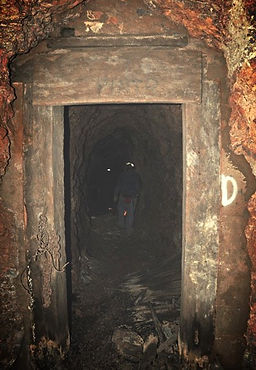Air doors (ventilation doors)

Air door inside the Queen Tunnel
Good ventilation is extremely important in underground mines. A well designed ventilation system can be used to control the temperature, quality of breathable air and in modern mines disperse radon gas. Air doors were used to prevent the passage of air through a mine working, in locations where access to the sealed area is still needed. Doors can be used to control the direction of the airflow through the mine. They also can be used to seal off parts of the mine to make it easier to build up air pressure if using a pressurized ventilation system. These doors were often used in pairs to create airlocks. The doors in these cases would be separated with enough distance to fit a motor and train of cars inside the airlock. Doors in high traffic areas where motors were used, had a compressed air opening system installed. The Queen Tunnel originally had one of these style doors installed near the bottom of the stairs to the stope. This system had an air cylinder mounted to the rib of the tunnel. Attached to the cylinder was a cable that went through some cable holders, a pulley then to the door. When approaching a door, the cylinder was activated by moving a leaver. The leavers were located from 50ft. to 200ft. in advance of the door. The cylinder will down stroke pulling the cable causing the door to open. Today all that is left of the mechanism is 6” x 8’ timber bolted to the tunnel rib. This timber held the air cylinder, valve and cables used in it’s opening. Air doors of this style were used until the underground mines shut down in 1975.

Standard air door compressed air operated with man door on left side.


6”x 8” timber rock bolted to rib of Queen tunnel used to hold air cylinder and cables.

Cable holder bolted to 6" X 8" Queen tunnel
Air doors located in areas with motor traffic had lighted signs or red lights warning the motormen of their location. Despite this, many times trains were run through the doors. The doors were typically constructed of wood, using two layers of 1” boards. One layer of boards would run horizontally and the next layer runs vertically. Between the layers of boards, roofing paper, brattice cloth or fire cloth was inserted. Sometimes the previous materials were used to cover the outside of the door instead of being put in-between the layers of boards. The door is hung with three heavy iron strap hinges. Often concrete was poured from the wood frame to the rock wall. The doors were designed to shut against the frame not inside the jam. The doors were made as air tight as possible. The doors came in three sizes standard, small and man. In the main haulage tunnels, equipped with the automatic standard doors it was common for them to have a man door in conjunction with it for safety. The Phelps Dodge rule book requires a 24” white target painted on both sides of all doors used in the haulage ways using locomotives.

Air door inside Queen tunnel closing counter weights are visible
The air door that is presently in the Queen tunnel near the 1100 ft. mark was installed during the tour renovations. At this time another air door was also installed and is located past 1700 ft. mark cave in. These doors open manually and are closed with counter weights. The manual doors can be very difficult to open because of positive pressure. At one of the mines I worked at in Colorado, one air door required three men to open. Usually just we tied a chain to an LHD(loader) and pulled it open.


Air door with targets Junction mine
Man door next to a blower on the 770 level Junction mine

Remains of air door 4 th level Southwest mine: note concrete poured around frame

Copper Queen style automatic door opener

Typical style of manual air door used in Bisbee

C & A style automatic door with man door on side
References
Code of safe practice for underground haulage p. 4 February 28,1958
Henry Hernandez 2010, pers. comm., March
Richard Graeme IV 2010, pers. comm., 8 March
Richard Graeme III 2010, pers. comm., 13 March
Standardization of mining methods p43-44 Mitke Charles 1919 ENMJ
Ventilation of the large Copper mines of Arizona 1930 bul 330 U.S. bureau of mines pp70, 81, 124,125,126